I stood upon the rugged flanks of Mount Parnassus and turned slowly, soaking in the 360-degree panorama. Behind me, pockets of fleshy pink limestone peeked from beneath the mountain’s gray shroud. Before me, a cluster of stately stone columns, carved from the pinkest stone, stood on a crumbling foundation. Giant blocks that once formed the famous Temple of Apollo had all but disappeared beneath swathes of tall grass. Yet despite its humble state, I was beyond excited to finally visit the site of the Oracle at Delphi. It was a journey I had been promising myself for more than 40 years.

My curiosity about Delphi began in my mid twenties when, on a whim, I decided to have a series of past-life regressions. During my second session, I was regressed to a lifetime at Delphi, where I was a young male slave who worked for the temple priests. My days were spent transcribing prophecies onto scrolls that were distributed throughout the kingdom. The revelation was so vivid that I simply couldn’t dismiss it. So when Collette invited me on their “Exploring Greece and Its Islands” tour, which included a visit to Delphi, I jumped at the chance.
The Delphic Oracle was known as far back as 1400 B.C. One legend says it was discovered by a shepherd who noticed his goats acting strangely near a chasm in the rock. When the goatherd breathed fumes being emitted from the chasm, he fell into a trance. Some who breathed the fumes claimed to receive prophecies, which were attributed to the goddess Gaia. Today we understand that the chasm was located at the intersection of two geologic fault lines. Whenever earthquakes occurred, water burbled up, steam belched, and toxic gasses were released from deep within the earth.
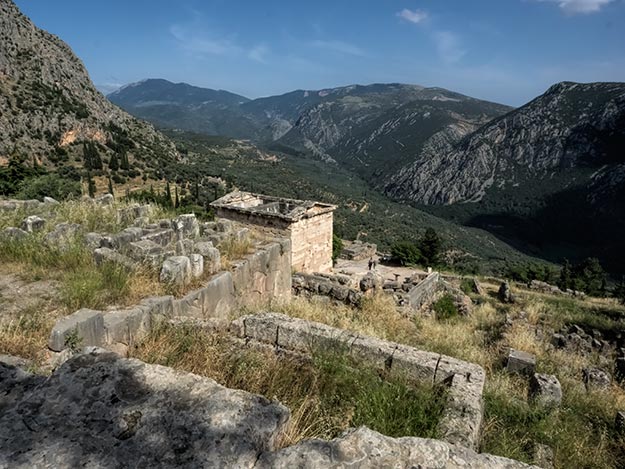
By the 8th century B.C., Classical Greek culture had transformed these pagan beliefs. To the Greeks, the Oracle was the voice of Apollo. Of course, no commoner could speak directly to the great god. That was the job of the Pythia, a high priestess of the Temple of Apollo, which had been built atop these fault lines. On the seventh day of each month, deep within the bowels of the temple, the Pythia sat before the Oracle, breathed in the fumes, and fell into a trance. People would ask her questions, she would consult the Oracle and answer. A priest would write her answers on a piece of paper and give it to the questioner.
After the 4th century, the Roman Emperor Therosyius closed down all ancient Greek religious sites. He turned Delphi into a quarry. Over time, 75 percent of all the buildings were dismantled and used to build other structures. Today only a few columns and scattered blocks remain, but the Oracle is said to be intact. I had my own questions for it. Had I made the right decision to move permanently to Thailand? What was I supposed to be doing with the rest of my life? Would I finally write that memoir I’d been working on for more than ten years? But at the moment, our entire tour group was gathered around the unassuming ditch that once led beneath the temple to the Oracle. I would have to wait a little while longer for my answers.

Though Delphi had been a motivating factor in my decision to travel with Collette, I was just as intrigued by their itinerary, which transported us back and forth between present-day and prehistoric Greece. Traveling around Greece with Collette was like having my very own time machine. On the island of Santorini, it carried me to the ancient ruins of Akrotiri, considered to be the most important prehistoric settlement found anywhere in the eastern Mediterranean. Human habitation at Akrotiri can be traced back as far as 5000 B.C., when it was a small fishing and farming village. By 3000 B.C., the city had become an important copper processing center and its location on the sailing route between Cyprus and Minoan Crete had bestowed tremendous wealth upon it.

Akrotiri enjoyed great prosperity for the next 500 years. Buildings that lined the harbor were three stories high and outfitted with indoor toilets – both rare in prehistoric settlements. The city had an extensive drainage system and its streets were paved. The remains of beautiful pottery and a series of murals, depicting scenes of flora and fauna from around the world, provide evidence of a wealthy and well-traveled citizenry. We know all this because, around 1627 B.C., at its absolute zenith, Akrotiri was buried by the Theran eruption. This second most powerful volcanic eruption in history completely entombed the city, leading some to refer to it as the “Minoan Pompeii.” Long held to be a Minoan settlement, more recent finds have led archeologists to opine that its origin was actually Cycladic.
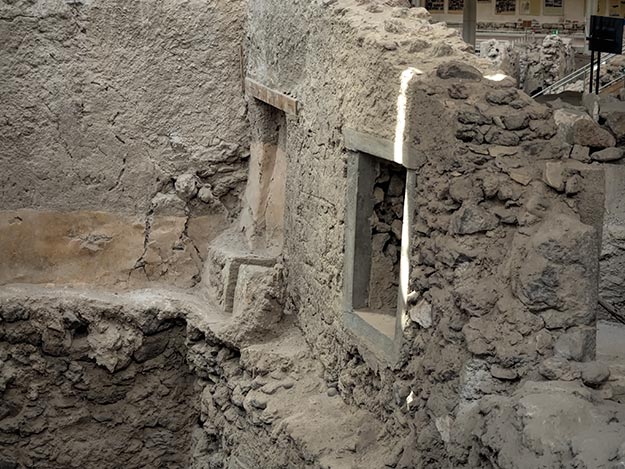
However, unlike Pompeii or Herculaneum, archeologists have not unearthed a single skeleton at Akrotiri, despite having conducted excavations since 1967. Almost certainly, residents would have felt earthquakes for days or even weeks before the final eruption. Archeologists theorize that the populace may have sheltered on higher ground rather than flee the island, as they would have known about tsunamis. To date, only the area around the harbor and commercial center have been fully excavated. As work proceeds inland toward higher ground, most experts expect that the residents will be discovered in a mass grave.

Another day, my time machine delivered me to the Citadel of Mycenae. This prehistoric civilization so dominated Greek culture in the second millennium B.C. that the period of Greek history from 1600 B.C. to about 1100 B.C. is named Mycenaean. From its perch atop a 900-foot high acropolis, the settlement enjoyed a far-reaching view across the Plain of Argos. In other words, they could see their enemy coming, and their enemies were many. The Mycenaeans were a war-like people, ruled by military leaders. Although they fished and grew their own olives and grapes, much of their time was spent raiding and looting towns. Indeed, by 1450 B.C. the Mycenaeans had grown so rich and powerful that they conquered the Minoan civilization on the island of Crete.
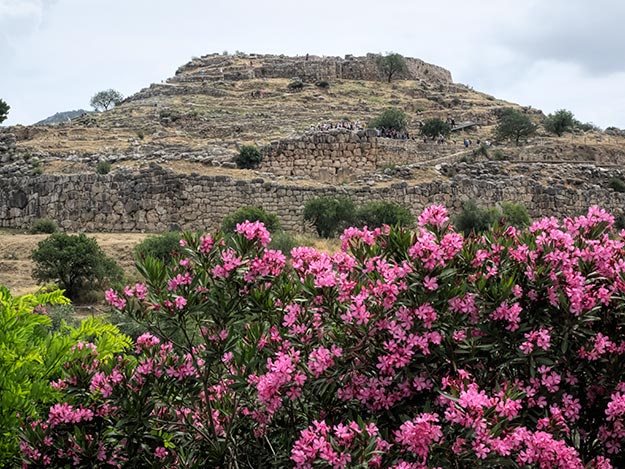
Fortunately, their hilltop location was a natural fortification. The only access to the city was via a steep path that led through a narrow opening in the rocks. Here they Mycenaeans built Lion Gate, a narrow doorway surrounded by immense stone blocks, topped by a massive stone lintel. Upon the lintel they carved two lions, rearing up in heraldic pose, facing one another. A legend grew up around these stone blocks, which were so enormous that mere mortals could not have put them in place. The stonework was said to be the work of the one-eyed giants known as the Cyclops. Soldiers would have been positioned around and above the gate, making an attack nearly impossible. I strolled up the path and paused in front of Lion Gate. Although the heads of the lions have long since been lost, it remains an impressive bastion. But back then, it must have been a fearsome warning to anyone thinking of challenging the Mycenaeans.
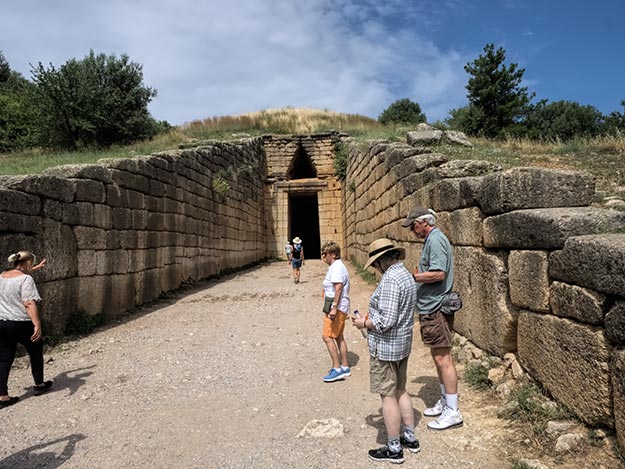
For me, however, Mycenae will always be best associated with Homer’s Iliad and the Odyssey. The two epic poems tell of the Greek’s struggle to rescue their queen, Helen, from her Trojan captors, and the subsequent fall of Troy. Every schoolchild knows the tale of the Trojan Horse, but nothing brings history to life more than standing on the spot where King Agamemnon of Mycenae ordered his troops to march off to Troy. Agamemnon, along with his Greek allies Achilles, Odysseus, Nestor and Ajax, prevailed, but their war raged for ten years. The city was already in decline by the time the king returned to Mycenae. By 1100 B.C., it had simply ceased to exist. No one knows for certain why or what happened.
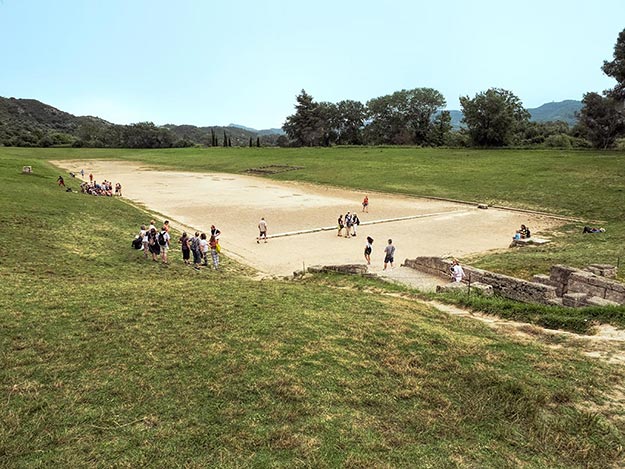
By this time I was getting used to traveling through time. I zipped ahead to 776 B.C., to a rectangular grassy field in Olympia, Greece. This was the site of the first Olympic Games. That initial competition consisted of a simple foot race known as a stade, a straight-line sprint of slightly less than 630 feet. More than 40 years elapsed before a second event was added at the 14th Olympiad. In this diaulos, competitors ran to the end of the field, turned, and returned to the start line. A long race that required competitors to run multiple laps of the course was introduced at the next Olympiad, and sports such as wrestling, boxing, long jump, discus, javelin, horse racing, and chariot racing were gradually added over the ensuing centuries.
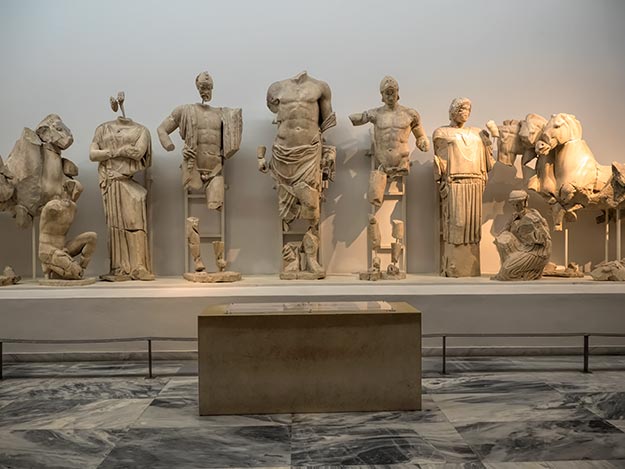
The religious significance of the games may have been more important than the athletic aspect. They were held in honor of the Greek god Zeus and scores of animals were sacrificed to him during the festival. Such ceremony demanded a site more appropriate to the god, so in 457 B.C. the Greeks built a temple and adorned it with a 43-foot high gold and ivory statue of Zeus that was considered to be one of the Seven Wonders of the Ancient World.
The Olympic Games were held in ancient Olympia until A.D. 393, when the Roman Emperor Theodosius ordered all pagan sites destroyed. Theodosius set the wooden roofs of the buildings alight and toppled the columns of all the temples and shrines. He also ordered all statues to be pushed over face first. As a result, the noses and penises of most ancient Greek statues are damaged. Archeologists speculate that this was done intentionally. Compared to the exquisite sculptures created by the Greeks, Roman sculpture was crude. Emasculating their statuary was symbolic of Roman domination over the Greeks.

Following the destruction of Ancient Olympia, a series of floods and earthquakes buried the toppled statuary. The city was abandoned and lost from memory until 1766, when the exact site of Olympia was rediscovered. Excavations began in 1829 and continue to this day. Many of the original buildings have been discovered, and scores of unearthed statues are on display at the Archaeological Museum of Olympia. The museum’s most magnificent piece is the sculpture Hermes and the Infant Dionysus, and the pediments from the Temple of Zeus have also been unearthed and pieced together in a stunning display. This past week, the Greek government announced that archeologists working at Olympia discovered a clay tablet inscribed with 13 verses from The Odyssey. Dated to the third century or earlier, the tablet may contain the oldest lines of the poet ever found in Greece. And since it was unearthed next to the Temple of Zeus, I’m quite sure I watched those same archeologists at work during my Collette Greek tour. Alas, the great gold and ivory statue of Zeus has never been found.
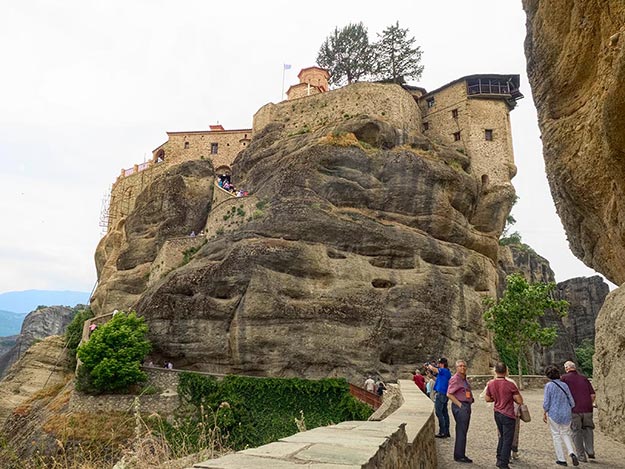
More than a millennia later, two priest/monk brothers, Theophanis and Nektarios Apsaras, began building the Monastery of Varlaam at Metéora. The site they chose was the top of a rock pinnacle that rises precipitously from the valley floor. My personal Collette time machine dropped me at the base of the long staircase and I began to climb. At each landing, I stopped to admire the view. Below me, other monasteries perched on rock turrets. Varlaam loomed far above me. The climb was tiring, but I had it good. Had it really been the 16th century, I would have been hoisted up by hand in a rope net.
Of the 24 monasteries that were originally built at Metéora, Varlaam is one of six that are still operating and open to the public. The exterior is gorgeous, but the interior really stuns. The inner sanctum is covered from floor to ceiling with original 15th century gilded frescoes. There was so much gold on the walls and ceiling that no lighting was necessary. Beams of sunlight mingled with candlelight and bounced around the room, multiplying the golden gleam. Cocooned in the warm liquid light, a profound sense of peace descended upon me.

In Greece, Orthodox priests must be married, preferably with families, but monks remain unmarried and celibate. At the time of its founding, about 35 monks lived at the Monastery of Varlaam. Today, only one 75-year old monk lives there full time, though he is often joined by other brothers who come for short stays. Each monk is required to pray eight hours a day, rest eight hours a day, and work eight hours a day. Keeping the icons clean is part of their duties, and they perform it well. Due to their efforts, not a single one of the paintings has ever needed to be retouched.
Our second stop in Metéora was the Holy Convent of Saint Stephen. Originally built in 1798 as a monastery, it was nearly demolished by bombing during WWII. It was abandoned for 20 years before being rebuilt and reopened as a nunnery. The inner temple of Saint Stephen is one of the few parts of the monastery that survived the war.
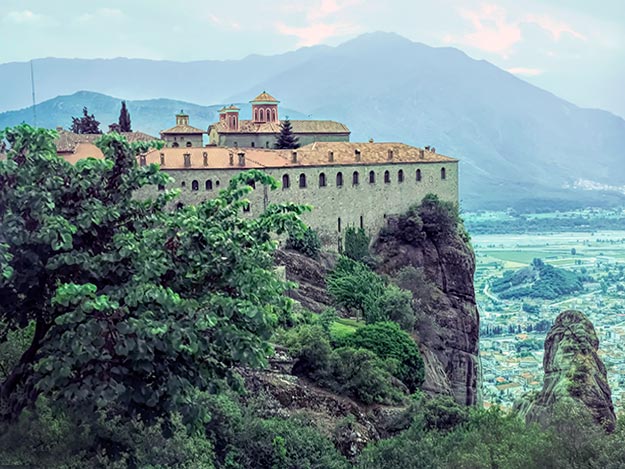
Vlasis Tsotsonis, one of the world’s most important modern hagiographers, has made it his life’s work to paint frescoes for the inner sanctum of the church. The nuns decide the subject of each painting, but Tsotsonis is free to choose the details for each painting. He uses real gold leaf, so there are some limits on what he is allowed to do, as the community must pay for the gold. Tsotsonis lives by a very strict code. Those who make Christian art must commit to live in a Christian way and abide by certain rules. The work is very demanding, requiring long hours. Tsotsonis has recently begun to worry that there will be no one to replace him. He has started teaching his techniques at the university, but few people are interested in what is largely considered to be a dying art.
Today, with 32 resident nuns, the Holy Convent of Saint Stephen is the biggest of all the monastic communities in Metéora. The sisters close the monastery every day at 5:30 p.m., lock the front door, ring the bell to call the nuns to worship, and pray until 9 p.m.
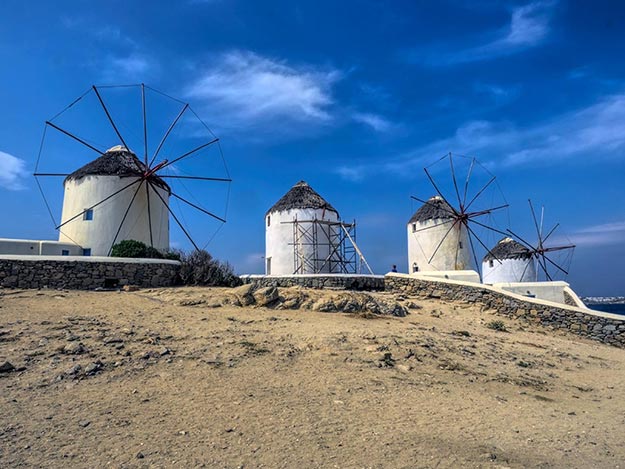
I took one last ride in the time machine, to the island of Mykonos, where the famous Kato Mili windmills arc across a hilltop in Chora town. Built by the Venetians in the 16th century, the windmills were likely the first commercial enterprise on the island. They milled locally grown grains, mostly wheat and barley. Some of the flour was returned to the farmers for their personal use, but most was sold to bakeries, which made “rusks,” a hard-tack bread that lasted for months. Every ship sailing in the eastern Mediterranean stopped at Mykonos to stock up on rusks, as it was often the main food on long voyages.
The Kato Mili windmills are no longer active and their canvas sails have been removed. Even so, they are remarkably attractive. On this island that has become the darling of jet setters, I was impressed that this lovely reminder of a time gone by had been so lovingly preserved. I was even more impressed when I discovered that “rusks” can still be purchased in local bakeries, though I caution anyone with weak teeth against biting into one.
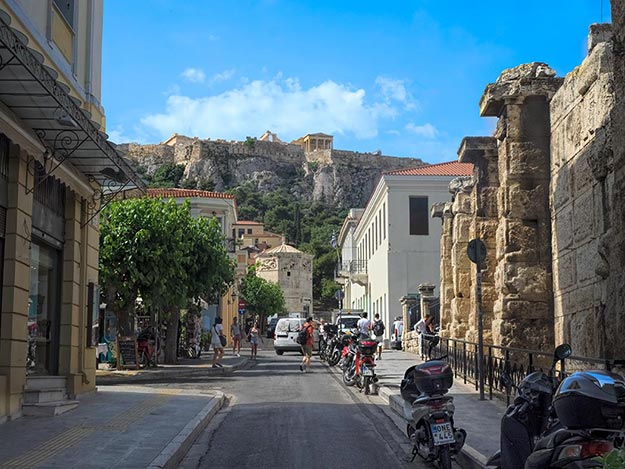
On the final day of our Greece tour, I stepped into a machine of anther kind – an airplane – for the trip back to Athens. Considering everything I had seen, Athens is still a must see destination in Greece, as it is home to magnificent sites like the Parthenon and the octagonal Tower of the Winds in the ancient Roman Agora.
It had been an exhilarating two weeks, crammed with 14 different sites and seven millennia of history. But the absolute highlight was Delphi, where I finally got my answers. When the rest of our group disappeared up a steep hill leading to the amphitheater, I sat on a rock overlooking the overgrown passage to the Oracle. I closed my eyes and breathed in the sweet smell of wildflowers and pine. One by one I asked my questions, but the Oracle refused to answer them. Instead, I was told to relax and enjoy life, to pay more attention to my health, to get eight hours of sleep a night, and to eat better. I heard that I need to get back to my Yoga practice and meditate daily. All good messages, though completely unexpected. Then again, I never expected to have lived a past life in Delphi, Greece, either.
Author’s note: I was a guest of Collette during my “Exploring Greece and Its Islands, featuring Classical Greece, Mykonos & Santorini” tour. Though my personal time machine is certainly fanciful, the guides that Collette provided at each local site were highly educated experts who were obviously passionate about their work. Again and again, they transported me back in time and brought ancient Greek history to life for me.

I have read so many posts on the topic of the blogger lovers but this paragraph is genuinely a good post, keep it up.
thanks admin shariong nice info
Hi Barbara- I took this same trip with Collette in 2017. It was magical, mysterious and awe inspiring. It is difficult to explain it to others and you have captured it perfectly in your article. When I read it I felt like I was there again. Your
pictures and mine are very similar.
Traveling with Collette was a wonder experience and the young woman who was our guide was exceptional. I can’t wait to travel with them again.
Hi Sharon: So glad to hear that you also had a wonderful experience with Collette. I’m very fortunate to be traveling with them again in August on a Scandinavian tour.
Hi Barbara,
I was looking at your beautiful photos, and ran across a picture of a man walking down a stone street in Greece with beautiful pink scrubs. This man had khaki shorts, sandals and bleach blonde hair and sunglasses. This looks so much like my brother, who passed away. He worked for one of the cruise lines and traveled to Greece a lot. I was just wondering if you had a date when this picture was taken. It was posted by Collette on Feb 10/18.
Hi Marla: I looked through my photos of Greece that have appeared in any stories and didn’t see a man who matched your description, however I was in Greece in the latter half of May in 2018.
pretty post..
bookmarked
Thanks Ayesha, happy you enjoyed it.
Fantastic article, Barbara! I had visited many of these sites 40 years ago (wow…that long ago??), and reading your descriptive story brought me right back there, but enlightened with historical account. Your trip sounds amazing, and I loved your connection archive to Delphi!
Hi Cris: Thanks so much for your lovely comment. I always love hearing that my articles made readers feel like they were traveling with me. It’s the highest compliment you can pay a writer. xoxo
This is such a great informative article about the Greek History. Thanks for sharing 7000 years of greek history in detail.
Greece is an amazing country, you should go visit Chrissi island next time you are there 🙂
Hi Vulcu – I’m not familiar with Chrissi island. I’ll check it out, thanks so much!
My favorite country, and Delphi is the most magical of many stunning sites. You will love chasing after Minoans in Crete. Plus the Turkish history, the World War II history, and the warmth and joy of living of the Cretan people. But one more part of Greece that you must see is south of where you were in Mycenae–The Mani–like nothing else in the world. Se Mistras and Monemvssia and the intriguing tower houses. People wanted to know why we kept going back to Greece. It is difficult to explain that each trip we were in a very different world (and time zone!).
Hi Vera. I was so impressed with Greece, for many of the reasons you state. Like you, I found the area around Mycenae to be fascinating and wished we’d had more time there, but as you know there’s SO much to see. Just gives me an excuse to go back, and I’m sure I will, and beyond just Crete.
The history in this country dazzles me Barbara. I mean, that far back, BC? Like a different time, a different era, so far back and removed from civilization today. Great pictures as always!
Ryan
Thanks Ryan. It left me hungry for more. Next I want to go to Crete to explore the Minoan civilization. So much wonderful history in this world!
I , too, visited some of these sites 20 years ago with Colette and reading your descriptions brought my trip vividly back to me. Thank you for your documentation of these marvelous sites!
You’re very welcome, Anita. Thanks so much for your comment. Collette is the best.